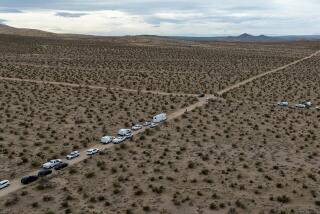Number of border crossers’ remains recovered in Arizona last year was lowest since 2001

Immigrants in Sasabe, Ariz., in 2007. The number of people in the U.S. illegally who perished trying to cross the southern Arizona desert in 2014 was the lowest since 2001.
The remains of 129 people who died trying to cross the U.S. border were recovered in the southern Arizona desert last year, the lowest number since 2001, authorities said.
But Pima County Chief Medical Examiner Gregory Hess said that didn’t necessarily mean fewer people tried to cross the unforgiving desert.
Border Patrol agents could have changed their routes, he told the Los Angeles Times, or smaller groups traveling together could be reducing the odds that someone would call emergency responders about a person who was left behind.
“The fact that most of the remains are skeletal means it’s unknown when they died,” Hess said.
The Pima County medical examiner’s office is responsible for analyzing the remains of “undocumented border crossers” collected along most of the Arizona border, including Santa Cruz and Cochise counties.
Others classified as border crossers who died elsewhere can come to the Pima County medical examiner’s office from as far north as Phoenix, where people who die bearing obvious signs of crossing the border are counted as unidentified border crossers.
“It may be 15 people after crossing the border in a truck near Phoenix at night with no headlights and it rolls, and five people die,” Hess told the Los Angeles Times. “Those five people would come to us.”
Most of the recovered remains were skeletal, most were men, and most were from Mexico, the medical examiner’s annual report said. In 84% of the cases, the cause of death was unknown.
The number of recoveries peaked in the summer, consistent with previous years, the report said. That number was far lower than the 168 recovered in 2013 or 156 in 2012, but still higher than 2001, when the remains of 77 people were found.
The worst year by far since the medical examiner’s office began collecting data was 2010, when 223 bodies were found, the report said – 99 in June, July and August alone, overwhelming the office.
Border crossing deaths constitute a tiny percentage of the bodies received by the medical examiner, but are often the ones that require the most attention.
The work can be agonizingly difficult. Without identifying documents, or with documents that may be fake, the process of tracking down survivors can be impossible.
Outside of the summer months, the number of recoveries last year was fairly consistent. Between nine and 11 remains were found in each month except January (12) and February (7).
More to Read
Start your day right
Sign up for Essential California for news, features and recommendations from the L.A. Times and beyond in your inbox six days a week.
You may occasionally receive promotional content from the Los Angeles Times.







